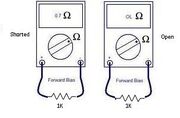About

A resistor and its color code values
About
A resistor ((Ω) symbol)) is an electronic component that resists, restricts, or opposes the flow of current. It can be visualized as constriction or narrowing in a pipe, where the constricted area is the resistance (resistor), and the flow of water is current. The volume of water flow following a constriction in a water pipe is reduced.
The resistive property of this type of component can be attributed to a material which has much lower electrical conductivity than regular conductive materials such as metals.
Ohm's Law can be used to calculate the resistance present in a DC circuit if voltage and current are known.[1]
Resistor check

Resistor check. A low resistance value indicates a short while a high (infinite) value indicates an open.
First make sure the power is off for the device, including battery power. Next, Adjust multimeter settings to test in "ohms." Put the multimeter probes on each end of the resistor. Because it has universal polarity, the multimeter does not have to be disconnected from any circuit. Lastly, compare to the readings from color code value chart. Any other value other than what the resistor is rated for indicates a problem with the component. A faulty resistor has a very low resistance value and can indicate a short while a high (near infinite) value indicates an open.
Resistance
Every resistor has a resistance calculated as:
where:
- R is resistance (ohms, Ω),
- V is voltage (volts, V),
- I is current (amperes, A).
Conductance
Conductance is defined as the inverse of resistance, calculated as:
where:
- G is conductance (siemens, S).
Voltage
Voltage is calculated as:
Current
Current is calculated as:
Power
Power is calculated as:
References
- ↑ E. J. Mastascusa . "Resistors." Bucknell University . 2008. http://www.facstaff.bucknell.edu/mastascu/eLessonsHTML/Resist/Resist1.html
Links
See also
Video

RESISTANCE




